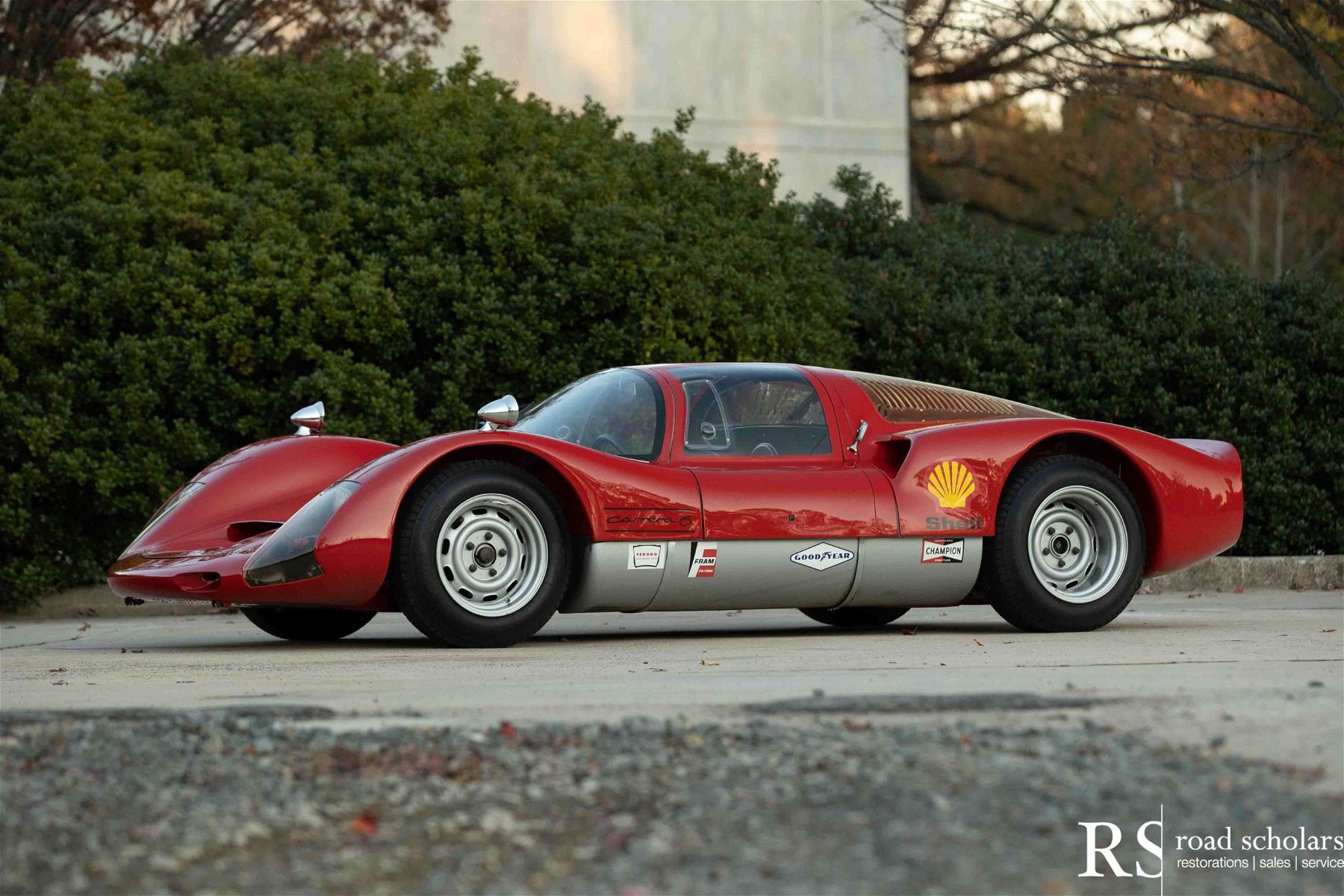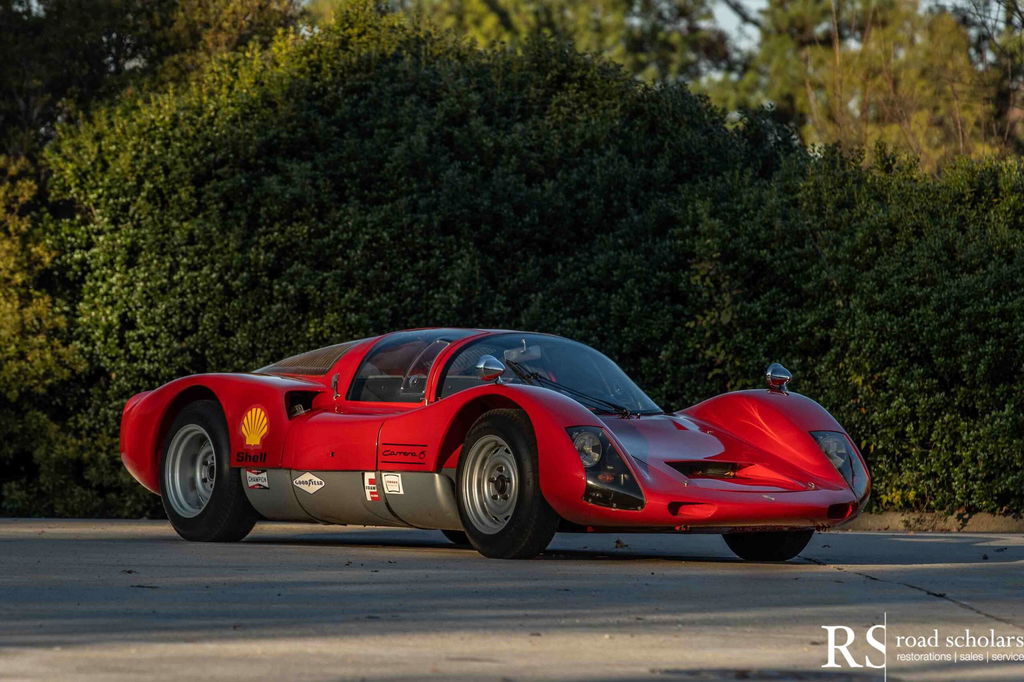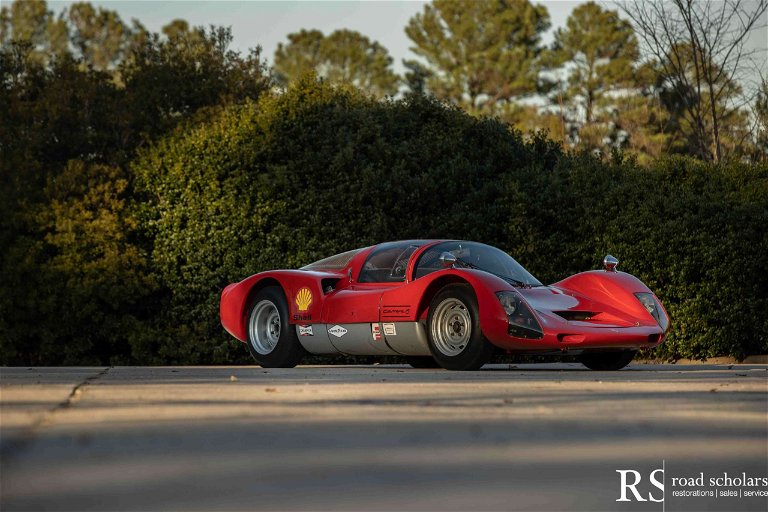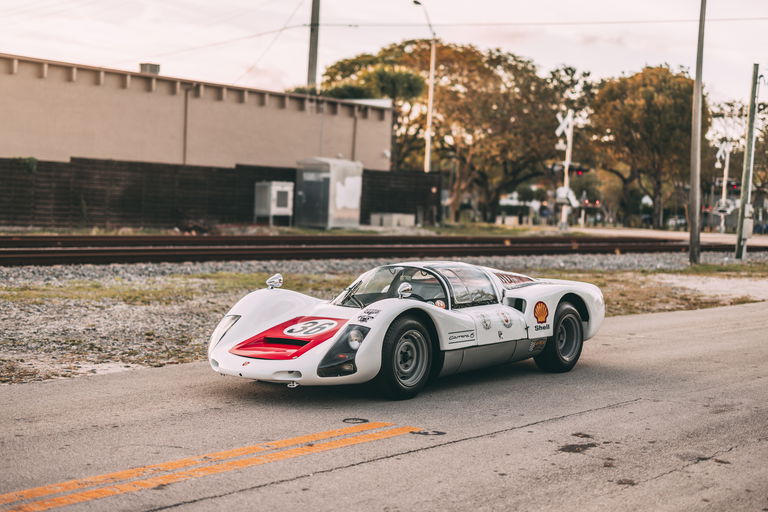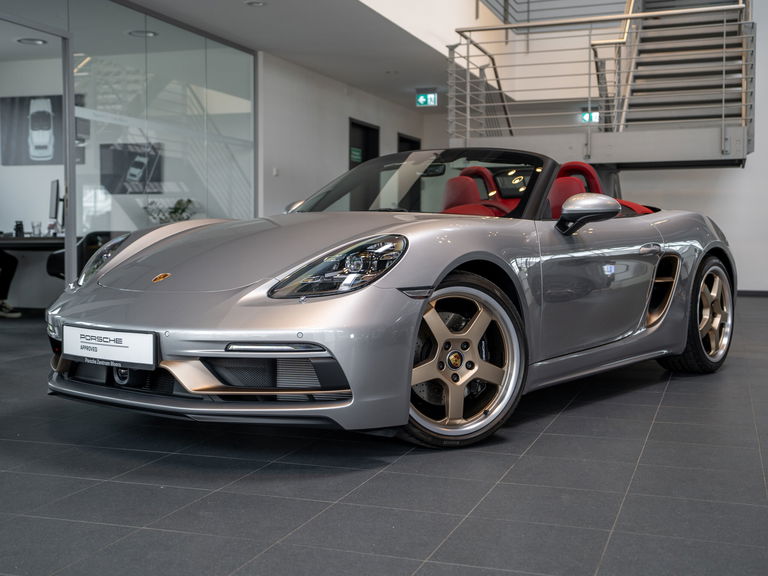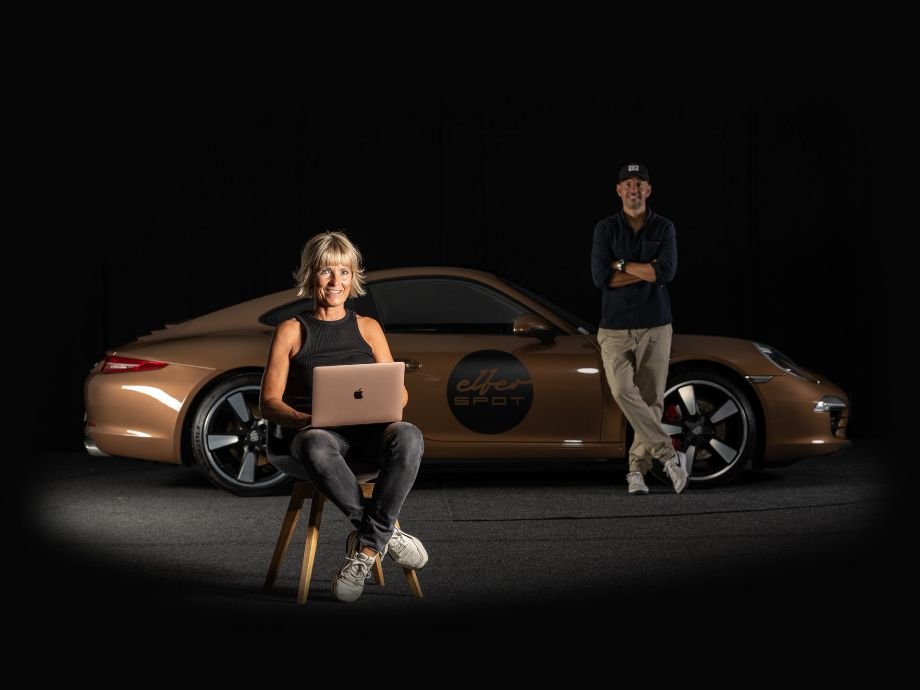The curvaceous fiberglass body was laid over a light and rigid tubular space frame and developed in the wind tunnel for optimal aerodynamic efficiency, resulting in a 0.35 drag coefficient. Large ducts behind the gullwing-style doors fed cool air to the rear brakes and transaxle, while ducts at the nose directed air to the oil cooler. The 2.0-liter engine was a high-strung iteration of the production flat-six from the 911 but tuned for racing with a 10:3:1 compression ratio and with lightweight titanium connecting rods and a forged steel crankshaft to minimize rotating mass.
A magnesium engine case shaved off crucial ounces, while sodium-filled exhaust valves were used in the cylinder heads. The engine was conservatively rated at 210 horsepower at 8,000 rpm and at 146 lb-ft of torque at 6,000 rpm, and the reduced mass of the internals allowed the engine to rev quickly and freely. The engine was mounted ahead of the transaxle for optimal weight distribution, and the production-based, fully-synchronized 5-speed transmission was available to suit the type of competition that it was destined for. The cabin was scant, at best, with little more than a rev counter and steering wheel, two pop-out plexiglass windows, and two fiberglass fixed bucket seats.
With oil and a dry fuel tank, the 906 weighed in at a mere 1,275 pounds and was capable of a top speed of approximately 170mph. Piëch and his team’s efforts made the 906 a dominant force against its competitors whose horsepower figures often greatly exceeded that of its own. Whether at the hands of the factory Werks team drivers or privateers, 906s claimed victories in all areas of racing- whether it be road rallies, endurance racing, or hillclimbs.
One of the many successful privateers who campaigned these featherweight racers was Josef “Sepp” Greger. Sepp was born in Scheyern, Germany in 1915 and made his dream to become a racer a reality in 1950. He competed in rallies throughout Germany and Europe with a Volkswagen Beetle, eventually making his way to the Rallye Monte Carlo. He observed that many of the decisive stints were the ones driven in the mountains, so he narrowed his focus to compete in hillclimb competitions. Despite his focus on hillclimbs, he found success in endurance racing in a number of the most challenging races of all time- including the Mille Miglia, the Nurburgring 1000KM, Monza, Hockenheimring, and even the 24 Hours of Daytona and 12 Hours of Sebring in the United States. Since Sepp ran a Volkswagen and Porsche dealership, the natural transition was to move from his Volkswagen Beetle into a Porsche as his next race car. Throughout Sepp’s lengthy 38-year-long career, he won the European Hillclimb Championship not once, but three times, came in as the runner-up in the European Hillclimb Championship three times and was crowned the German Hillclimb champion three times. In total, Sepp claimed 236 victories and finished on the podium 380 times. Like Piëch’s lightweight race cars, racers like Sepp were a force to be reckoned with.
In 1966, Sepp purchased chassis 906-127 new from the factory in Signal Red paintwork with engine number 906-132 and gearbox 906-123. During his ownership, engine number 906-132 was exchanged for 906-162. Sepp campaigned it in its first race on May 8, 1966, at the Hansapokal (Nurburgring) where he secured a second-place finish. It was a good start to the season but Sepp was determined to claim victory, and he did exactly that. In fact, he completely swept the hillclimb scene in his quest to take the championship. He proceeded to take back-to-back first-place finishes in each of the next twelve hillclimb in the 1966 season. Of the 14 races, Sepp took 12 overall victories, one second-place finish, and one DNF on the very last race of the season. That single DNF, however, didn’t hinder his standing whatsoever, and he handily walked away with the Championship victory.
Between 1966 and 1968, Sepp competed in a total of 40 hillclimb events throughout Europe and Germany, regularly claiming podium finishes and outright victories. In the 1968 Freiburg-Schainsland Hillclimb, a faulty fuel line leaked gasoline onto the hot exhaust and caused a fire. Remarkably, by Sepp’s own account only the fan shrouds, some electrical wiring, the undertray, and decklid were damaged, and after replacing them 906-127 made it to the next hillclimb event.
After the 1968 season, Sepp sold 906-127 to fellow privateer, Kurt Hild in Munich, Germany. Hild continued to race 906-127 for two full seasons throughout Germany in the 2-liter division. Of the 17 races he entered with the 906, he claimed five podium finishes including a third-place finish at the 1969 Season Finale at Hockenheim and an outright victory in the 1970 Airport race Geilenkirchen.
Following the 1970 season, Hild sold 906-127 to Manfred Pade of Dusseldorf, Germany. Pade campaigned the 906 in 12 hillclimb races in 1971, taking a total of 5 first-place finishes and three second-place finishes before converting the standard 906 bodywork to a Spyder configuration. He raced it in four races, taking two victories and a third-place finish before selling the car to Herbert Adamczyk. Adamczyk brought the car to Macau where it was used as a road car and entered into the Macau GP in November of 1973. Adamczyk competed with Jim Sweeney for approximately two years with 906-127. In 1978, Bob Garretson purchased the 906, still with Spyder bodywork, and imported to California. Eventually, it was sold to Michael Hager in Tustin, CA. By the early 1980s, it was completely disassembled and in need of a complete restoration. In 1986, 906-127 was sold through Kerry Morse to Gerry Sutterfield, then Jeff Hayes later the same year.
For nearly two decades, 906-127 remained in the same state until Kevin Jeannette purchased the car and subsequently sold it to Jean Goutal of New York in 2003, who in turn commissioned Jeannette to undertake a painstaking restoration from the ground up over the course of three years. It was stripped to the bare chassis, all components were cleaned and correctly repainted and re-plated with the correct coatings. The entire body was correctly assembled with existing original body panels and newly molded panels. A correct magnesium case motor (number 903-133) and correct gearbox (number 906-157) were fitted, and the bodywork was repainted in the same Signal Red paintwork that was specified when Sepp took delivery of the 906 in 1966. During the restoration, Sepp Greger consulted throughout the restoration process to confirm historical details and was instrumental in the decision-making process to ensure its accuracy. He was also able to visit Gunnar Racing in 2002 and before its completion in 2005 to confirm numerous details and share his stories of 906-127 in its heyday. Sepp joked that the lightening holes drilled in the pedals were the secret to his success in hillclimb competition and that in the process he may have forgotten to clean all the metal shavings from the footwell. In 2005, Jean Goutal met with Manfred Pade in Dusseldorf, Germany. Here, Jean was presented with the original Momo Monza steering wheel that Manfred purchased and installed on the 906 to replace the original wood steering wheel that the 906 came equipped from the factory with. The Monza steering wheels were only produced for a short time because the spokes were prone to cracking. The steering wheel presented to Jean is in incredible, unrestored condition and accompanies the car.
Following the completion of the restoration, it was displayed at Rennsport Reunion at Daytona in 2007 and took first in its class courtesy of the meticulous attention to detail of Gunnar Racing’s restoration. Two years later, in March of 2009 it was shown once again at the Amelia Island Concours, where it was awarded second place in its class and the coveted Porsche Award.
In 2010, James Lindsay of the UK took ownership of 906-127 and prepared it for track use. He entered the 9011 Spa 6-Hour race and showed it at the Castle Concours shortly thereafter. In 2012, it changed hands once more, returning to New York with its most recent owner. He had a second high-performance motor built and is currently fitted to the car. The early aluminum sand cast engine case was built for Speedsport in 12/2012 to 2.3-liter specification and incorporated a brand-new set of Italian Weber carburetors, and the completed engine produces 228 horsepower to the wheels and 176 lb-ft torque. A dyno sheet is included mapping the horsepower and torque curves. The fresh, correct 906 motor (number 906-133) accompanies the car on an engine stand.
Its most recent owner has driven chassis 906-127 on multiple occasions, including three of our Piëch to Peak road trips through hundreds of miles through the mountain passes of Colorado, and at our track events such as the RS Invitational at Road Atlanta. It has been maintained regularly by our service shop and has undergone a handful of modifications to make it more comfortable when being driven for extended periods of time. Firstly, a new clutch and pressure plate was fitted in place of the racing clutch, and then a PCI Race Radio system with Bose noise-canceling headphones with an intercom system was installed allowing the driver and passenger to communicate with each other and the other drivers in the group, or to pair to a phone through Bluetooth and listen to music. A custom cool box was made with an in-line blower and vents were added to provide cool air into the cabin. A custom aluminum catch can was made and installed in place of the brittle original plastic unit.
Along with the car, a cache of period photos and race results document the more than 80 races over six continuous seasons of competition that 906-127 campaigned in. Also included is the original Porsche factory Kraftfahrzeugbrief, the ONS Wagen-Pass outlining the technical documentation under Manfred Pade’s ownership and confirming the serial number of the chassis at each race, correspondence from Porsche to Sepp Greger from 1966, the factory Kardex, an FIA Heritage Certificate, and a comprehensive timeline of 906-127s ownership from new. A four-inch thick binder chronicles Gunnar Racing’s exacting restoration in numerous photographs and written documents.
Few 906s, if hardly any, can boast such complete documentation of ownership and provenance, and rarely retain the original documentation that chassis 906-127 has retained over the five and a half decades since it left the factory. Additionally, it is exceedingly rare to have the original owner intimately involved throughout the restoration to authenticate the intricacies of the car. 906-127 is believed to be the winningest 906 to have survived, and its thorough documentation make it one of the best examples in existence.
Highlights:
- Purchased new by Sepp Greger
- 906-127 took the 1966 European Hillclimb Championship with Sepp Greger (Driver/Owner)
- Of the 14 races, 906-127 took 12 overall victories in 1966
- Unprecedented documentation including; original Porsche factory Kraftfahrzeugbrief, ONS Wagen-Pass, correspondence from Porsche to Sepp Greger from 1966, the factory Kardex, an FIA Heritage Certificate
- A comprehensive timeline of 906-127s ownership from new.
- A four-inch thick binder chronicling Gunnar Racing’s exacting restoration in photographs and written documents.
- A cache of period photos and race results document the more than 80 races over six continuous seasons of competition that 906-127 campaigned in.
- Comes with original type 901/20 Carrera 6 engine #906-133
- Magnesium transmission #906-157
- 906-127 currently has a 2.3-liter type 901/06 engine that was fully rebuilt by the 901 Shop in Stuart, Florida. It was built to be a high-performance engine while still being street-able. Horsepower was rated at 228 horsepower/176 lb-ft torque to the rear wheels.
